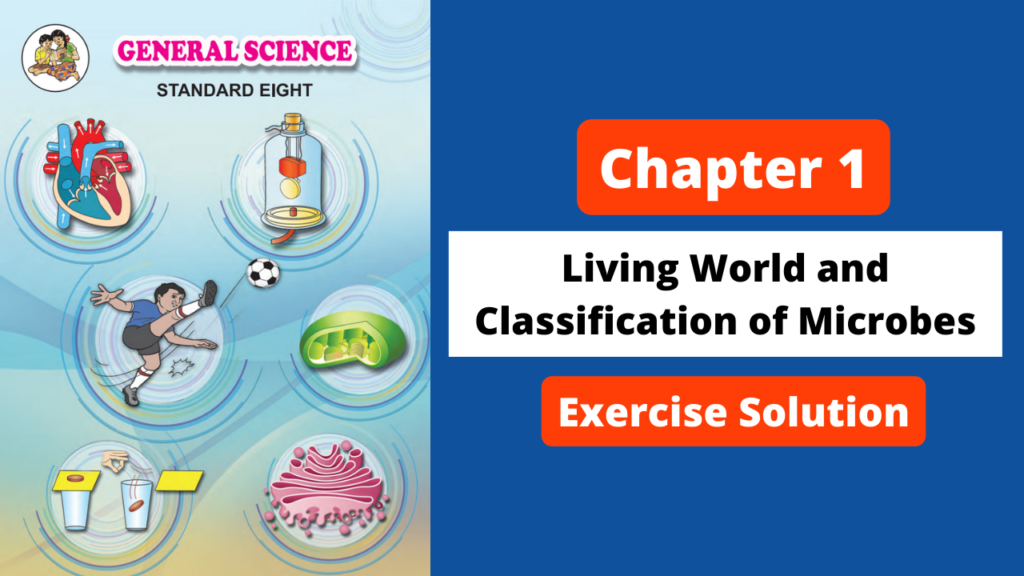
1. Following are some statements about pollution. Which type of pollution do those express:
a. Fog seems to be appearing in Delhi during day hours.
Answer:
Air pollution-Smog
(The sentence should have the word Smog and not fog. Smog is fog with smoke. Only fog cannot be polluting, but the smog is.)
b. Many times, vomiting and dysentery occurs after eating ‘panpuri’.
Answer:
Water pollution-Contaminated food and water due to bacteria or virus
c. Problem of sneezing occurs sometimes during visit to garden.
Answer:
Air pollution due to pollens
d. Crop does not grow up in some areas.
Answer:
Soil pollution
e. People living in the busy squares face the problems like short breathing and other respiratory problems.
Answer:
Air pollution due to traffic
2. Read the passage and identify the sentences expressing types of pollution.
Nilesh is a student of Std. VII and lives in urban area. It takes about an hour to go to the school by bus. He faces the heavy traffic of two wheelers, four wheelers, rickshaws, buses while going to school. He is facing the problem of asthma since last few days, Doctors recommended him to stay away from urban area. Since then, his mother sent him to the village of his maternal uncle, Nilesh saw the heaps of garbage at many places in village. Foul smell of human and animal wastes was present at many places. Blackish water with foul smell was flowing in a stream. He developed some abdominal disease within few days.
Answer:
- It takes about an hour to go to the school. (Due to traffic jam, Nilesh is spending more time in polluted, contaminated air.)
- He faces the heavy traffic. (Large scale combustion of fossil fuel.)
- He is facing the problem of asthma. (Air pollution – Harmful to human health.)
- The heaps of garbage at many places. (Solid waste – Land pollution.)
- Foul smell of human and animal wastes. (Biological pollution, air pollution.)
- Blackish water with foul smell was flowing in a stream. (Improper sewage management – Water pollution.)
- He developed some abdominal disease within few days. (Water pollution – Effect on human health.)
3. Match the pairs from ‘A’ and ‘B’ columns and explain the effect of pollution on human health.
| Column ‘A’ | Column ‘B’ |
| 1. Water containing cobalt | a. Mental retardation |
| 2. Methane gas | b. Paralysis |
| 3. Water containing lead | c. Inflammation of lungs |
| 4. Sulphur dioxide | d. Skin cancer |
| 5. Nitrogen dioxide | e. Irritation of eyes |
Answer:
| Column ‘A’ | Column ‘B’ |
| 1. Water containing cobalt | b. Paralysis |
| 2. Methane gas | d. Skin cancer |
| 3. Water containing lead | a. Mental retardation |
| 4. Sulphur dioxide | e. Irritation of eyes |
| 5. Nitrogen dioxide | c. Inflammation of lungs |

4. True or false.
a. Water does not get polluted by washing the clothes in running water of river.
Answer:
False. (Even if washing of soiled clothes is done in running water, it will cause pollution as the dirt and the waste materials will be added to water. This certainly will cause water pollution.)
b. More the use of electric appliances, more will be the pollution.
Answer:
True. (Most of the electricity is generated in India by burning coal. The power generation plants thus cause lots of air pollution. More the electricity is used by using more appliances, there will be more pollution. However, only power generation through solar energy cannot cause pollution.)
5. Answer the following:
a. What is pollution?
Answer:
Contamination of natural environment that can harmfully affect the environment is called pollution.
b. What are Pollutants?
Answer:
The products which affect the normal functioning of ecosystem and have an adverse effect on plants, animals and humans are called pollutants.
c. What is acid rain?
Answer:
1. When rainwater contains harmful amounts of nitric and sulphuric acids, it is called acid rain.
2. Burning of fossil fuels such as coal, wood, petroleum, etc. releases nitrogen oxide and sulphur oxide into the atmospheric air.
3. Since these oxides are soluble in water, they dissolve in rainwater. Nitrogen and sulphur oxides dissolved in large quantities of water vapour form acids like nitric acid, nitrous acid, sulphurous acid and sulphuric acid.
4. These acids mix with mist, drops of rainwater and snow. They change their composition and fall back on the ground in the form of acid rain.
5. Effects of acid rain are as follows:
- Increase in the acidity of soil and water bodies.
- Damage to the trees.
- Water becomes unsuitable for fish and wildlife.
- Buildings, statues, sculptures, bridges, monuments and fences are corroded due to acid rain. Thus, acid rain damages our national assets.
- Acid rain affects agriculture and crop lands.
d. What is greenhouse effect?
Answer:
- Greenhouse effect is the ; phenomenon due to which global warming and climate change occur.
- The earth receives solar energy in the form of heat from the sun. The surface of earth absorbs this heat and reflects it back to the atmosphere as infrared radiation. Some of this heat energy goes directly into space.
e. Which are visible pollutants known to you?
Answer:
1. The polluting substances that are seen easily with the naked eyes can be called as visible pollutants. E.g. Solid wastes, plastic articles, plastic bags, the suspended things in the water, metal refuse, etc.
f. Which are invisible pollutants?
Answer:
The pollutants which are completely dissolved in water or mixed in the air, cannot be seen and hence they can be called invisible pollutants. Since they are not seen, we remain unaware about the presence of these pollutants. E.g. the insecticides spread f on the crops. Aerosols, many hazardous gases in the air, toxic compounds that are totally soluble in water, etc.
6. Answer the following.
a. Give two examples of each of water, soil and air pollution from your residential area.
Answer:
Air pollution:
- New buildings are constructed. Old structures are demolished. This is creating lots of dust pollution. The air is full of particulate matter.
- The number of vehicles on the road has tremendously increased. This causes smoky environment.
Water pollution:
- The sea shows lots of floating plastic and decaying flowers, etc. When beaches are visited it is a common sight.
- Many fishes are seen dying in great numbers and are washed off to the shore.
Soil pollution :
- Everywhere garbage heaps are seen. In that plastic bags, needles, old medicine vials and cartons are seen in abundance.
- The sludge brought by rainwater is spread everywhere and that causes stink.
b. How does the pollution occur due to vehicles? Give the names of vehicles causing least pollution.
Answer:
- More than 50% of the air pollution is caused by vehicular traffic.
- Particulate matter, unburnt hydrocarbons, CO, nitrogen oxides and carcinogenic hydrocarbons are present in the automobile exhausts.
- Fossil fuels like petrol, diesel, natural gas, gasoline, etc. which are burnt to run the automobiles lead to the emission of CO2 and other gases.
- Therefore, vehicles are said to be the major contributors to air pollution.
- The only vehicle which is non¬polluting is bicycle. The four-wheelers which are battery operated are also manufactured recently.
These two types of vehicles are eco-friendly. The cars that run on C.N.G. are also said to be lesser polluting.
c. What are natural reasons causes for water pollution?
Answer:
The natural causes of the water pollution:
1. If organic pollutants are added to the water there is an overgrowth of weeds such as Eichhornia. The growth of algae also makes the water unsuitable for consumption. These aquatic plants release oxygen during daytime but by night they require oxygen thus depleting the dissolved oxygen level. The natural characters of water are then changed.
2. The decomposing matter when added to the water make it polluted and stinking.
3. Due to deposition of sludge or eroded soil, the rivers change their path and divert from original flow. The currents are also changed. Deposition of sludge makes the water polluted.
4. Due to soil erosion, surrounding the water bodies, the microbes, bacteria, protozoans and the worms and larvae of nematodes enter the water causing severe biological pollution. Many inorganic pollutants are also added to the water. The fungand bacteria present in the water make it non-potable. Such water spreads water-borne diseases.
d. Suggest four preventive measures for air pollution.
Answer:
The following methods are adopted to control air pollution from the industries:
- The source discharge is diluted by tall chimneys.
- There are source correction methods like changing the raw material, equipment modification, process modification, etc.
- Effective pollution controlling equipment like dust collectors, electrostatic precipitators, wet scrubbers, etc. should be used.
- There should be ban and control over atomic tests and chemical weapons on the international level.
e. Explain relation between greenhouse effect and global warming.
Answer:
Because of greenhouse effect, there is increase in the global temperature. The heat on the earth remains trapped due to envelope of greenhouse gases. The percentage of carbon dioxide and methane is constantly increasing and hence there is increase in the temperature too. Thus the greenhouse effect is directly related to the global warming.
Effects of this relation between greenhouse effect and global warming are as follows:
- The polar ice caps and the glaciers at both the poles are melting due to increased temperature.
- The oceans’ water is rising due to this melted ice. The sea level rise is causing coastal land submergence. The islands at various regions are threatened of drowning.
- Many species of living organisms are already extinct due to global warming. The rest are also threatened.
- Wild animals are showing weird migrations. Polar bear is endangered.
- The increased temperature of the oceanic water is causing many changes in the tides and currents. This results into increased occurrence of cyclones, hurricanes and cloud bursting. The natural disasters are rising in last decade.
- The agricultural production is decreasing. The regions with less rainfall are facing draughts.
f. Construct two slogans each on air, water and soil pollution.
Answer:
Air pollution:
- Be a part of the solution and not part of pollution.
- Show your care, clean your air.
Water pollution:
- Water, water everywhere, Not a drop to drink. The pollution is making all the water stink.
- Save the fish and the little turtle. Don’t throw plastic or it will encircle.
Soil Pollution:
- Don’t be mean, keep environment clean.
- Let’s keep land clean, together only we can win.
7. Classify the following pollutants into natural and manmade categories.
Sewage, dust, pollen grains, chemical fertilizers, vehicular smoke, algae, pesticides, waste of animals and birds.
Answer:
| Man-made | Natural |
| 1. Sewage | 1. Dust (Natural) |
| 2. Dust (Construction related) | 2. Pollen grains |
| 3. Chemical fertilizers | 3. Algae |
| 4. Vehicular smoke | 4. Waste (Excreta) of animals and |
| 5. Pesticides |


